David Linkie looks back 20 years to a six-day trip on Amethyst II BF 19 that marked a significant milestone for the Scottish prawn fleet
Four weeks after Macduff Shipyards completed the 19.9m twin-rig trawler Amethyst II, skipper David West and Ralston Johnston delivered on their offer, made three years earlier, of a trip if they built a new boat to replace Opportune BF 19.
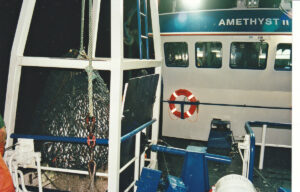
Taking a codend aboard on Amethyst II.
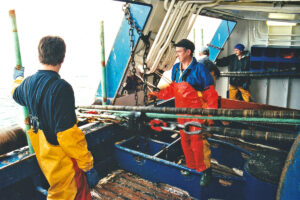
Working the gear on an enclosed quarter was a new experience for the crew.
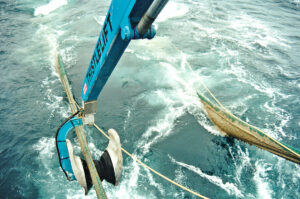
Lowering the block to pick up the starboard net…
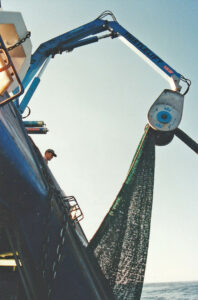
… before raising it…
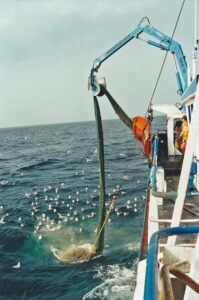
… to swing the bag forward.
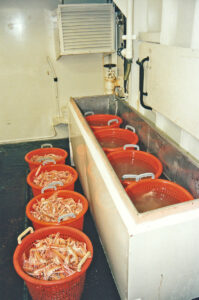
Amethyst II was the first boat in the Fraserburgh prawn fleet to feature a chilled dip tank to enhance catch quality.
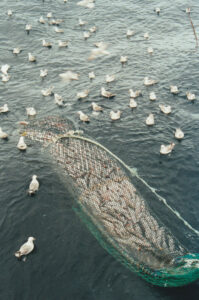
The second tow yielded one and a half lifts of ling and haddock.
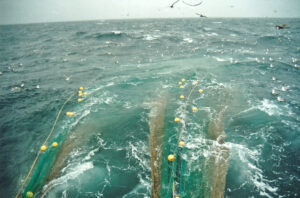
Shooting away the Faithlie Trawl 200ft twin-rig whitefish nets.
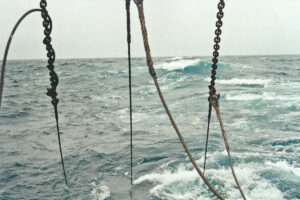
Towing the gear from a central banana bar.

The 820kg roller clump coming aboard at the end of a tow.
As the first of a new class of compact twin-rig trawler, designed to combine maximum efficiency and fishing performance with realistic building costs and viable running expenses, the level of performance that Amethyst II delivered on her shakedown trips was followed closely by skippers looking to replace existing converted vessels, many of which had been built more than 25 years earlier.
The boat was big enough to work offshore, while also being economical to work closer to home. In the first three weeks, when she landed 850 boxes, Amethyst II was never more than 40 miles offshore. Skipper David West expected to continue to work six-day trips, sailing on a Sunday night, with five men aboard and two ashore – a system that gave a week off every two or three weeks.
The week of this trip in August 2000, the crew consisted of second engineer Roy Johnston, net/fishroom man David Smith, Jim Mowat and Ally Park, with mate and partner Ralston Johnston and driver Willie Ironside having a well-deserved week ashore.
Although Amethyst II had already completed three successful six-day trips that had yielded in the region of 300 boxes of prawns and whitefish, David West and his crew were still in the process of fine-tuning their fishing gear, to achieve maximum catch and boat efficiency.
After throwing their bags aboard, the crew quickly took one link out of the backstraps on the Perfect B 84 600kg trawl doors, to ensure that they stood higher and gave increased spread.
“The first few trips have gone OK. Other skippers have passed on valuable information on rigging the gear. Now it is up to us to complete the final few tweaks in order to get the optimum performance from the vessel. A northerly gale on the first trip gave an immediate opportunity to gauge the vessel’s seakeeping qualities, which proved highly favourable,” David West said, after easing Amethyst II out of Fraserburgh harbour the back o’ Sunday.
“Taking on any new boat requires skill, time and patience to realise its full potential – never mind rigging out what is every inch a new and very different class of vessel.”
Amethyst II’s crew said they were finding the vessel easy to work, being particularly impressed with the fish-handling system and the space on the foredeck and around the net drums. From starting the auxiliary engine for the hydraulics to shutting it down again usually took no more than 40 minutes.
On the first trips, when Amethyst II was towing at between 2.7 and 3 knots from 1,400rpm, the Flo-Scan meter indicated that at this setting, with 450rpm in hand, the trawler typically used 65 litres per hour when towing the prawn nets, and 70 for the whitefish trawls.
David West expected this figure to increase towards 90 litres when towing up through a gale of wind. On the first three trips, daily fuel consumption for Amethyst II’s main engine averaged around 2,000 litres per day. During this six-day trip, 9,200 litres were used. These figures compared favourably with her predecessor Opportune, which used on average 1,500-1,650 litres per day, when towing at 2.2 knots.
David West reasoned that the £1,500 difference between the weekly expenses of Opportune and Amethyst II – which took the expenses to around £1,000 per day – was reasonable, given the increase in catching potential.
With reports of poor fishing coming in on the fax, the crew quickly downed a mug of tea as skipper David West decided to use his fish nets and set course for a bit of hard ground only 40 miles off, to target mainly ling. After a relatively short haul in the vicinity of the Galatea C wreck, the codends surfaced for the first time at 6am, to reveal around 10 boxes of bulk in each net. David West had been hoping for more, but considered the result worth another tow, so the gear was quickly shot away again in 60 fathoms.
Amethyst II was towing a set of 200ft ground rope whitefish twin-rig trawls, rigged on 6in and 8in discs, made by Faithlie Trawl of Fraserburgh. The 180ft headline was rigged with 38 8in floats to ensure that the net stood high. To give maximum headline height, 150 fathoms of 20mm-diameter Dyfrom compact steel core wire were shot for the second tow, compared to 175 fathoms for the first. The 70-fathom sweeps were made up of 20-fathom splits made from 18mm-diameter wire and 50mm rubber legs, followed by 40 fathoms of 26mm-diameter single combination warp, although these were expected to be replaced with 28mm warp for the winter months.
Amethyst II was using a set of Perfect B 600kg trawl doors to spread the gear, in conjunction with an 820kg middle clump manufactured by Macduff Shipyards.
The gear arrangement on Amethyst II was considerably larger than that used by David West aboard Opportune, which had only 100kW less and towed 175ft trawls in conjunction with 50-fathom sweeps, 7ft Dunbar Hi-Flight double-keeled V doors and a 385kg chain clump.
The sweeps were attached to the trawl doors by 32ft of chain backstraps. In order to create maximum spread, the middle warp was worked 12ft shorter than the outer wires. With the more powerful Amethyst II, this difference was all on the fore side of the door, while on the Opportune, it was either side of the trawl door.
Like most boats in the fleet, Amethyst II shot the 830kg middle clump first, then the doors, shot with the hydraulics in to keep a constant strain on the gear. Hauling was the reverse, with the doors being chained up first, although this procedure would be reviewed with the onset of winter.
In use for the first time, the Marport door sensors, supplied by Woodsons, showed an average door spread of 59 fathoms, with which David West was satisfied. As well as a continuous digital readout, the door opening was also displayed in the form of a graph, providing valuable help in fine-tuning the gear.
On the second haul, the starboard codend surfaced first to reveal a better showing of fish, which subsequently yielded one and a half lifts of mainly haddock and ling, with a few flats. With poor reports starting to come in from those boats fishing at the Forties, David West decided to stay where he was for the rest of the day, which ended with 35 boxes of fish and four of prawns from four hauls.
Twin-rig trawlers that had steamed from Fraserburgh to the Noup grounds following reports of 7st of prawns from boats that had fished there over the weekend were now reporting between 15 and 20st per haul. Although this was attractive, David West was reluctant to steam 120 miles, by which time a large fleet of vessels would be on the grounds – although he accurately predicted that catch rates would increase to 35st per haul the following day.
After steaming 50 miles northeast during the night past the Tartan and Ivanhoe rigs, Amethyst II shot away the similarly sized Pisces prawn nets alongside John Watt’s Excel in 80 fathoms early on Tuesday morning, near the Strathgarry wreck on the Martins grounds, north of the Piper oilfield.
Eleven hours and two hauls later on a fine bright day, 16 boxes of good-quality live prawns and 20 of fish, mainly haddocks, had been stowed in the fishroom. The presence of two washers meant that the catch could be stowed below very quickly.
The fish-handling system was mechanics-free, to eliminate any difficulties resulting from drive failures while at sea. After being released from the codend into the receiving hopper, the catch was gravity-fed onto a table, which led aft. Standing against the starboard side of the boat, the crew sorted and gutted the catch from this platform. Selections were placed into elevated baskets, while prawn tails were directed into baskets on the deck via separate chutes.
Separate prawn and whitefish washers were fitted abaft the fishroom hatch. Whitefish were released from the washer into a chute leading to a sorting table in the fishroom, from where they were boxed.
Because of the presence of fish, David West asked his crew to shoot the 100mm fish nets again, but not before they had removed some of the headline floats to lower the headline, to keep more meshes on the bottom and help keep the prawns in the net. The third day was dull and grey, with a moderate to fresh southeasterly – not the best of conditions for the deepwater.
Catch rates dropped to around 10 boxes of fish, mainly good medium haddocks, and eight of prawns – although the quality was good, with at least two boxes of large and four of medium a haul. Eventually, the prawn nets were back in use, although not before showing the conservation benefits of using a bigger mesh.
Managing four hauls a day, Amethyst II had 140 boxes aboard by Thursday morning, and was now fishing alongside such boats as Lorena II, Genesis, Vertrauen and Good Hope.
While fishing during darkness was yielding little more than five boxes of prawns and fish, the first daylight tow on Thursday yielded 21 boxes, including 11 of fish – again good haddocks, with the odd box of green.
With a northerly breeze coming away, this proved to be as good as it got, as more boats arrived in the area. Ten boxes of good prawns continued to be the norm, with not more than two of tails not exceeding a count of 60. The daylight haul on Friday again proved the most successful, with 19 boxes. By now, Amethyst II was fishing further east, where the bottom had become noticeably softer, and so the gear was mudded up. A fastener early on Saturday morning resulted in three hours repairing headline damage, before the gear was shot again at dawn.
After towing past the 25m Sundari and Ulysses, haul 22 came aboard at Saturday teatime, after which David West set course for Fraserburgh, 90 miles into the southwest, with 160 boxes of fish, including 90 of haddocks, and 120 of prawns: 17 large, 26 medium, 50 small and 24 tails.
On arrival at Fraserburgh at 4am – which worked in well with my plan to catch the first flight from Aberdeen to Shetland, in order to go to sea on the Burra seiner Comrades the following morning – the prawns were immediately landed, while being monitored by local fishery officers, to Peter Duthie of C-Shells Ltd for consignment to Glenmar Shellfish, Skibbereen. The whole prawns were of excellent quality and averaged £68.53 per box, with the large making £36/st. Tails ranged from £17 to £19 per stone.
The whitefish was landed at midnight on Sunday to the Fraserburgh market, with the ling making a healthy £84 per box on the Monday morning sale.
Amethyst II leads the way
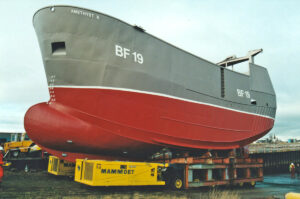
Amethyst II, showing her large displacement hull form, ready for launching on Teesside.
Built to replace the 20m wooden-hulled twin-rig trawler Opportune BF 19, Amethyst II was the first of a new class of high-specification compact prawn/whitefish twin-rig trawler designed to combine the capability to fish offshore with viable new build and running costs.
Amethyst II’s under-20m hull was developed by Macduff Shipyards in response to requests from skippers of similar-sized wooden boats for modern tonnage suitable for fishing on North Sea grounds up to 150 miles from Fraserburgh for a mixture of prawns and whitefish.
Optimising towing capability, one of the key requirements for the new design, was achieved by moving up to a 7.5 reduction gearbox and 2,100mm-diameter nozzle – significantly more than the 4.5:1 box and 1,600mm propeller typically found on wooden-hulled vessels that had been converted to twin-rig trawling after being built for seine-netting or single-boat trawling.
The double chine hull of Amethyst II included a ballasted box keel, bulbous bow and bulbous skeg forward of the propeller. The hull sides were continued up to the full-length steel shelterdeck, which – in another notable first for this size of vessel – enclosed the net drums on the quarter.
With a beam of 7.30m and moulded depth of 4.20m spread over the full length of the hull, Amethyst II was built to tow, returning a bollard pull of around 11t – almost double that of Opportune.
Towing ability was helped by the fact that the Caterpillar 3412TA main engine (487kW @ 1,800rpm) was reserved solely for propulsion, rather than running the hydraulics via a step-up box, as was common practice on older vessels.
Instead, the hydraulics were run off a dedicated Mitsubishi 6D22 auxiliary engine of 177kW @ 2,000rpm, driving the deck machinery through a fore-end clutched splitter box.
Electrical supplies came from Newage Stamford 58kW 415/3/50 generators driven by Mitsubishi auxiliary engines, run week about to extend engine life and facilitate easier maintenance.
The large hull form permitted a fuel capacity of 30,000 litres, more than double that carried by Opportune.
Manufactured by Macduff Shipyards, the deck machinery installed on Amethyst II also represented a significant step up. Mounted forward on the main deck, the two-speed three-drum trawl winch had a core pull of 30t. Each drum was spooled with 250 fathoms of 20mm steel core wire that led up from the drums to run over the top of the shelterdeck, with the middle wire leading under the wheelhouse floor.
Two 2 x 12t split net drums were arranged side by side on the quarter.
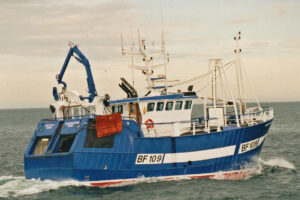
The very similar Celestial Dawn…
A combined 5t anchor/Gilson winch – the first to be manufactured by Macduff Shipyards – took the codends aboard forward of amidships, where a square-framed lifting gantry was positioned over a hydraulically operated hatch.
Thistle Marine Ltd supplied the HAP deck crane and 24in powerblock fitted atop the trawl gantry, which also incorporated a short middle frame for handling the twin-rig clump, which was hauled into a safe box. Amethyst II was fitted with a curved towing bar and sliding block free to assume the optimum position relative to the boat when towing, promoting greater catching efficiency and boat handling.
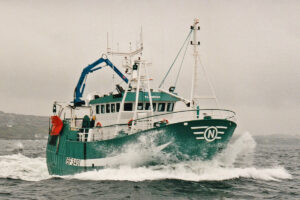
… Flourish N…
Amethyst II also incorporated two other notable firsts for the Scottish fleet. These were a Marport TSS 2000 net-monitoring system and a chilled prawn dip tank.
Chilled to between 3°C and 5°C by a dedicated compressor, the covered aluminium tank enabled four baskets of whole prawns to be dipped simultaneously for a few minutes before being boxed in the fishroom. This provided an initial quick temperature drop for the prawns, and avoided placing them in water, which could rise several degrees above sea temperature in conventional dipping tanks on a summer’s day.
Over 700 boxes and 16t of ice in two wing lockers could be accommodated in the fishroom, in which chilling systems were fitted on the deckhead and both bulkheads.
A well-equipped galley and messdeck was positioned fore and aft on the port side of the deckhouse. Shower, storage and toilet facilities lay to starboard, on the opposite side of the companionway linking the foredeck to the quarter. An eight-berth cabin was arranged down the aft stair.
Four months after Amethyst II started fishing, Macduff Shipyards completed the very similar Celestial Dawn BF 109, for George Hepburn and Sandy West. Two small differences were that Celestial Dawn’s wheelhouse was moved forward two frame spaces to create more room on the shelterdeck abaft the wheelhouse, and that the nozzle/propeller diameter was increased by 100mm to 2,200mm.
Macduff Shipyards completed the third new build of this class, Flourish N BF 340, for Gardenstown skipper Zander Nichol, little more than a year after Amethyst II started fishing. The only significant difference on this build compared to the previous two was that an additional set of net drums were fitted atop the shelterdeck, taking advantage of the extra room created by moving the wheelhouse forward on Celestial Dawn.
A fourth twin-rig prawn trawler to the same design, Fruitful Bough PD 109, was built in its entirety by Macduff Shipyards in 2004 for Peterhead skipper James West.
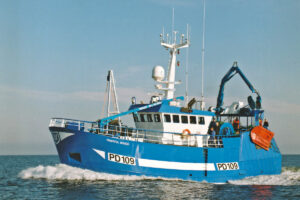
… and Fruitful Bough were built in quick succession by Macduff Shipyards as the new class of vessel quickly proved its capabilities.
The first three new builds – the hulls of which were built under subcontract by Aveco (Teesside) Ltd and towed to Macduff for machinery installation and full fit-out – replaced three wooden-hulled boats, Opportune BF 19, Celestial Dawn BF 109 and Grateful BF 340, which had a combined age of 52 years and had all been converted to twin-rig trawling after being built for either fly-shooting or single-net trawling.
The subsequent consistently successful performance achieved by these boats led to these vessels, and others that followed, quickly becoming known at Fraserburgh as the ‘bright lighters’. Over the next two decades – the start of which saw the last big wooden-hulled boat, Adele BF 36, launched at Macduff – the yard built 30 twin-rig trawlers to various design derivatives developed in line with continually evolving trends.
Today, all four boats continue to fish from Fraserburgh and Peterhead. George Hepburn has skippered Celestial Dawn from new, while Amethyst II was renamed Virtuous FR 253 in 2003, before becoming Orion BF 432 in 2010. Flourish N became Shalanna BF 843 in 2017 when Macduff Shipyards built Steadfast Hope BF 340 for skipper Zander Nichol, and last year Fruitful Bough was renamed Gracious PD 103.








